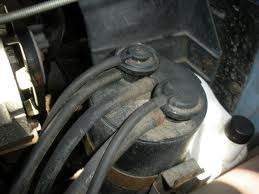Vapor Fuel Leaks
As mentioned earlier, you can have a vapor leak as well as a liquid fuel leak on a gasoline engine. From as far back as the 70s, auto manufacturers have incorporated evaporative emission systems on their vehicles. They do this for a couple of reasons. The first is to reduce hydrocarbon emissions from the vehicle. The second reason is to save fuel. Evaporating fuel is a fuel loss, plain and simple. The more fuel that evaporates, the less you have in the tank. You might be surprised at how much fuel can be lost just by leaving your gas cap off.
For this reason, manufacturers have sealed the fuel system and created a mechanism that stores evaporative fuel emissions in a charcoal canister. When certain conditions are met, this sequestered fuel vapor is routed back to the engine to be burned in the combustion chamber. The system is somewhat complex in its operation; it involves a set of sensors and solenoid valves to help direct and control the flow of the evaporative emissions in your vehicle. When there’s a failure in the system, it usually sets off the check engine light. Some modern systems even have a separate light just for a loose gas cap. If you see this light come on, check and tighten the gas cap as necessary. This should reset the light if you’ve sealed everything back up. If you still have an issue, you might need to take your vehicle in to find the source of the leak. In the meantime, you might try replacing the gas cap. I recommend an OE cap if you go this route for best results.
No matter what, you don’t want to ignore these leaks, especially if you have emissions testing in your area. A check engine light for an evaporative emission failure is an automatic fail of an emissions test. In addition, it takes time for the system to reset itself even after you repair the leak. It might take weeks to meet the right conditions in order for your vehicle to run the self diagnostic test on the evaporative emission system. Yes, you can force the system to run the test early, but this might require a proprietary scanner capable of running the test on your vehicle. Aside from the check engine light on your dash, you will likely not notice any difference in vehicle performance. However, you might smell the fuel leak. This might aid in finding the source of the leak. “Just follow your nose,” as Toucan Sam says, but in this case, you’re not looking for breakfast cereal, you’re looking for fuel leaks.
Not all evaporative emission leaks are external, however. Sometimes a solenoid goes bad and the leak is internal. To find these leaks, it’s good to have a smoke machine and a service manual that shows the testing of the different components of the system. I often get asked if the DIYer can fix an evaporative emission problem. My answer is, not often. Every once in a while someone gets lucky and replaces the right part based on something they read on the Internet, but most of them replace part after part to no avail. Without the proper testing equipment and information, you’re kinda flying blind. In addition, even if you manage to fix the leak, it might be some time before you can verify the repair due to the length of time the system needs to run its self diagnostic, as mentioned above. If you don’t have the proper testing equipment, you might leave evaporative emissions work to a professional. I don’t often say that, but in this case it might actually save you money. Ignorance can get expensive.
Video Title: Vapor Fuel Leaks- Finding and Fixing Fluid Leaks -EricTheCarGuy. Video Description: Fuel leak types come in the form of liquid leaks and vapor leaks. Let’s start with vapor fuel leaks. Thumbnail: http://www.ericthecarguy.com/images/faq_buttons/leaks/Finding_and_Fixing_Fluid_Leaks_850.png
 Our Address
Our Address



